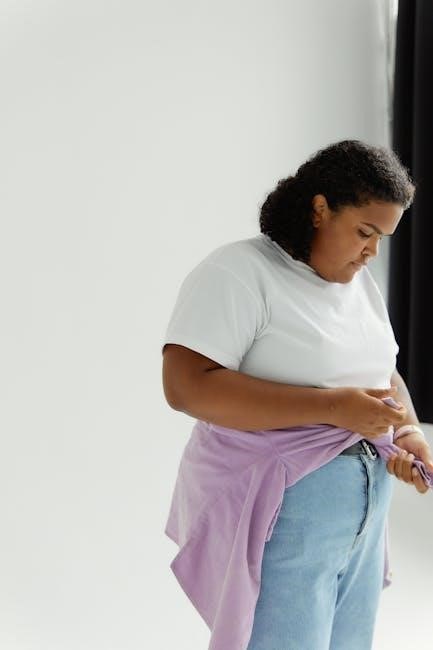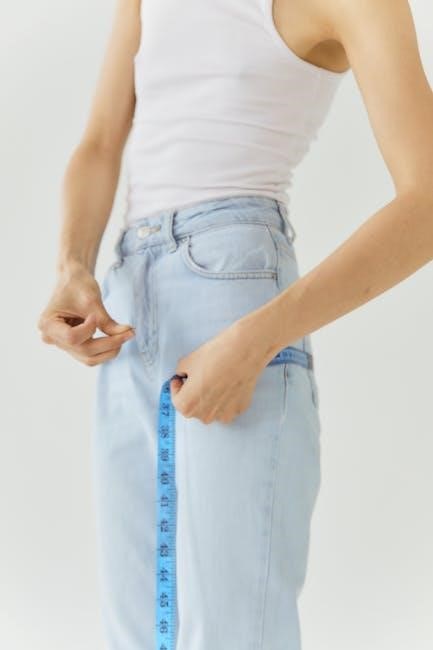Women’s Jeans Size Chart
A women’s jeans size chart provides standardized measurements for waist, hip, and inseam to ensure a perfect fit․ Sizes range from 23 to 34 inches in waist measurements, with corresponding hip sizes․ Vanity sizing and style variations can affect fit, so comparing measurements across brands is essential for accuracy․ Always consider the specific cut and stretch of the jeans when selecting your size․

Understanding Waist, Hip, and Inseam Measurements
When shopping for women’s jeans, understanding key measurements is crucial for the perfect fit․ The waist measurement refers to the smallest part of your natural waistline, typically just above the belly button․ The hip measurement is taken around the fullest part of your hips, usually 7-9 inches below the waist․ The inseam measures the length of the pant leg from the crotch to the ankle, determining whether the jeans are petite, regular, or long․ These measurements form the basis of women’s jeans sizing and vary slightly by brand due to differences in cuts and styles․ While vanity sizing can cause inconsistencies, relying on actual measurements ensures a more accurate fit․ Always use a tape measure to determine your personal measurements for the best results․
How to Measure Your Waist, Hips, and Inseam
To measure your waist, wrap a flexible tape measure around the narrowest part of your torso, just above your belly button, ensuring it’s level and not too tight․ For your hips, measure around the fullest point, typically 7-9 inches below your waistline, keeping the tape measure horizontal․ The inseam is measured from the top of the inner thigh down to the ankle bone, indicating the pant leg length․ These measurements are essential for accurately using a women’s jeans size chart․ Always take measurements while standing up and wearing thin clothing for the most precise results․ Using these steps ensures you can find the perfect fit, regardless of brand or style, and helps navigate any variations caused by vanity sizing or different cuts․
How to Choose the Right Women’s Jeans Size
Selecting the right size involves comparing your measurements to a size chart, considering factors like stretch, cut, and style․ Ensure comfort and fit by trying sizes close to your measurements, as vanity sizing can vary between brands․ Always check the specific sizing standards for each brand to achieve the best fit․
Using the Size Chart for Accurate Fit
Referencing a size chart is crucial for ensuring an accurate fit․ Start by measuring your waist, hips, and inseam․ Align these measurements with the chart to find your corresponding size․ Note that vanity sizing can cause variations, so double-check each brand’s specific standards․ For instance, a size 6 in one brand might equate to a size 8 in another․ Consider the style—slim-fit, boyfriend, or high-waisted—and how it affects measurements․ If shopping online, use the chart to guide your selection․ Remember that inseam lengths vary, so choose based on whether you prefer cropped, standard, or long jeans․ Always prioritize comfort and how the jeans sit on your body for the best fit․
Factors Affecting Fit: Stretch, Cut, and Style
The fit of women’s jeans is influenced by several factors beyond size․ Stretch refers to the elasticity of the fabric, with materials like elastane providing comfort and flexibility․ The cut, such as slim-fit, boyfriend, or high-waisted, determines how the jeans sit on the body․ High-waisted styles often offer more coverage, while slim-fit styles hug the legs tightly․ Style variations, like cropped or bootcut, also impact fit, as they alter the silhouette and inseam length․ Additionally, the rise of the jeans—whether low, mid, or high—can affect comfort and aesthetics․ Understanding these factors helps in selecting jeans that flatter your body type and meet your lifestyle needs․ Always consider these elements alongside size measurements for the best fit․

Women’s Jeans Size Conversion Chart
A women’s jeans size conversion chart helps compare US sizes with international standards, ensuring accurate fits across brands․ Use it to find equivalent sizes globally and try them on for the best fit․
US to International Size Conversions
Converting US women’s jeans sizes to international standards requires understanding the differences in sizing systems․ To convert US sizes to UK sizes, add 4 (e․g․, US size 8 equals UK size 12)․ For EU sizes, add 30 (e․g․, US size 8 equals EU size 38)․ Japanese sizes are calculated by adding 3 (e․g․, US size 8 equals Japanese size 11)․ These conversions serve as a general guide, but variations exist due to differing measurement standards and vanity sizing across brands․ For instance, a US size 32 in jeans typically corresponds to a UK size 14 and an EU size 42․ Always refer to brand-specific size charts for the most accurate fit, as styles and cuts can influence sizing․ Plus sizes may also vary significantly between regions and brands, so checking the conversion charts is essential for international shoppers․
Men’s to Women’s Jeans Size Conversion
Converting men’s jeans sizes to women’s sizes involves understanding the differences in fit and measurements․ Generally, men’s jeans sizes are based on waist and inseam measurements, while women’s sizes incorporate both waist and hip measurements․ To convert, subtract 21 from the men’s waist size to approximate the women’s size (e․g․, men’s size 33 converts to women’s size 12)․ However, this is a rough estimate and varies by brand․ For example, a men’s 36×32 jean might correspond to a women’s size 15․ Factors like inseam length, style, and fit (e․g․, slim, regular, loose) also influence the conversion․ Always refer to the brand’s size chart for accuracy, as sizing can differ significantly․ Trying on jeans or using detailed measurements ensures the best fit, especially when shopping across genders or brands․


Frequently Asked Questions
Common questions include understanding size variations, handling vanity sizing, and converting sizes between brands or genders․ Measuring accurately and using size charts helps find the best fit․
Why Do Sizes Vary Between Brands?
Women’s jeans sizes differ between brands due to inconsistent sizing standards and vanity sizing․ Some brands adjust measurements to make sizes appear smaller, while others prioritize comfort over strict measurements․ Additionally, factors like fabric stretch, style cuts, and fit preferences can cause variations․ For instance, a size 8 in one brand might fit like a size 6 in another․ This inconsistency makes it essential to consult each brand’s size chart and consider personal measurements when shopping, especially online․ Trying on jeans or using customer reviews can also help navigate size discrepancies and find the best fit․
How to Handle Vanity Sizing
Vanity sizing, where brands adjust sizes to make customers feel slimmer, complicates finding the right fit․ To navigate this, focus on measurements rather than numbers․ Use the brand’s size chart to align your waist, hip, and inseam with their specifications․ Ignore the labeled size and prioritize how the jeans feel․ If shopping online, read reviews to gauge fit consistency․ Trying jeans on in-store allows for a more accurate fit assessment․ Remember, sizes vary, so don’t be discouraged if your size differs across brands—your comfort and confidence are what truly matter․ By emphasizing fit over labels, you can overcome the challenges posed by vanity sizing and enjoy a flattering, comfortable pair of jeans․

Finding the perfect fit in women’s jeans requires understanding measurements, using size charts, and considering factors like style and stretch․ Confidence and comfort are key to your ideal pair․

Key Takeaways for Finding Your Perfect Fit
Accurate measurements of waist, hips, and inseam are crucial for determining your size․ Use a size chart specific to the brand and style, as vanity sizing can vary․ Consider the cut and stretch of the jeans, as slim-fit and high-waisted styles may fit differently․ Don’t rely solely on numeric sizes; focus on how the jeans feel․ If possible, try them on to ensure comfort and fit․ When shopping online, refer to brand-specific charts and read reviews for insights․ Remember, sizing standards differ globally, so international conversions may be needed․ Ultimately, confidence and comfort in your choice are the most important factors for your perfect fit․
